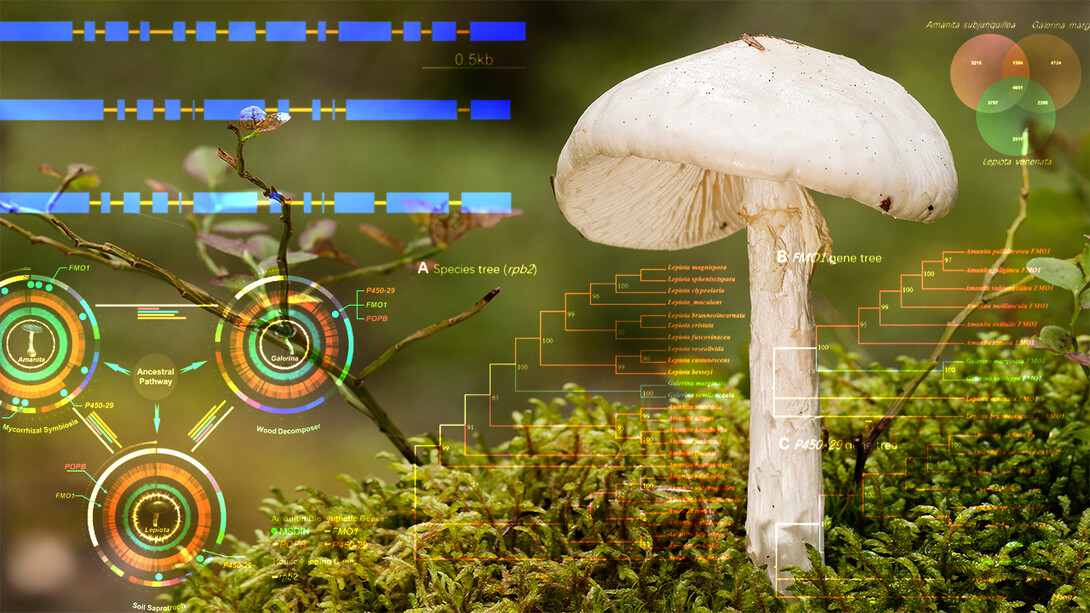
Autumn skullcap. Death cap. Destroying angel.
What’s in a name? To hear Juliet tell it, not much. But what’s in the mushrooms bearing those names — a poison potent enough to decommission a human liver within days of consuming as little as one mushroom cap — could have felled Romeo, too.
Some 90% of the mushroom-related deaths worldwide originate from Amanita, a genus whose edible species can sometimes resemble its deadly poisonous. Amanita’s most toxic toxin, alpha-amanitin, is also commonly found in two other genera of mushrooms: Galerina and Lepiota.
The surprise? Though the genera share the toxin, they don’t share much of a lineage. They don’t share a lifestyle, either. Whereas the amanitin-producing Amanita species live in symbiosis with trees, Galerinas subsist on rotting wood, while Lepiotas secrete enzymes into soil and feed on the detritus within.

“From the very beginning, we wanted to know why and how these unrelated genera are producing this same, fairly complex-looking chemical,” said Heather Hallen-Adams, associate professor of practice of food science and technology at the University of Nebraska–Lincoln.
Usually, such a striking adaptation would arise and get passed down, or vertically transferred, to the genera from a common ancestor over many generations of sexual reproduction. But Hallen-Adams and her colleagues have unearthed new evidence that genes responsible for alpha-amanitin were instead horizontally transferred — that an “unknown ancestral fungal donor” independently passed those genes directly to living specimens of the three genera by means also unknown.
As exotic as it seems, horizontal transfer has been well-documented in prokaryotic, single-celled forms of life, especially bacteria, where the phenomenon can spread genes responsible for antibiotic resistance. The viruses that invade bacterial cells are often to blame for that horizontal spread, though other routes exist.
About 15 years ago, Hallen-Adams and the Chinese Academy of Sciences’ Hong Luo published research suggesting that certain genes responsible for synthesizing alpha-amanitin in mushrooms stemmed from horizontal transfer, not vertical.
“It’s now accepted in fungi,” Hallen-Adams said of the phenomenon. “When this was proposed in the early 2000s, that was not really the case. There was a lot of pushback that this could happen in eukaryotes.”
In a new study published in the Proceedings of the National Academy of Sciences, Luo, Hallen-Adams and colleagues analyzed the sequenced genomes of 15 amanitin-producing species spanning the Amanita, Galerina and Lepiota genera. The team identified two more genes — FMO1 and P450-29 — as essential to refining the especially lethal, final form of alpha-amanitin.
Both genes direct the production of proteins that modify an early phase of the toxin by affixing chemical compounds that effectively activate or amplify its deadly powers. When the researchers disrupted the FMO1 gene, they found that the mushrooms failed to produce alpha-amanitin all together. Deleting P450-29 yielded a previously unreported toxin roughly 1,000 times less potent than alpha-amanitin.
The team also compared the chromosomal locations of those two genes and others, including MSDIN and POPB genes that were the subject of its earlier studies, across the 15 mushroom species. In the Galerina species, the amanitin-relevant genes were tightly packed together on a chromosome, spanning a range of just 100,000 base pairs (the fundamental components of DNA). By contrast, Lepiota’s amanitin-encoding genes encompassed roughly 2 million base pairs and were scattered “all over the place,” Hallen-Adams said. Amanita’s, meanwhile, sprawled across upward of 30 million base pairs, or 300 times the genetic footprint of Galerina’s.
Those differences extended beyond just the density of their chromosomal neighborhoods to the gene families residing within them. Galerina’s MSDIN family of genes, for instance, can produce only one cyclic peptide, or ringed chain of chemical compounds: alpha-amanitin. That pales against Amanita’s MSDIN gene family, which has grown to the point that it can potentially produce hundreds of different cyclic peptides — 45 of which have been confirmed, some of which might eventually be enlisted in the fight against cancers and other diseases.
“Cyclic peptides tend to be biologically active compounds,” Hallen-Adams said. “There’s a lot we can do with them. They can be good pharmaceuticals. Unfortunately, they’re not really easy to synthesize; it can be done, but getting a bioactive cyclic peptide strictly in a lab is difficult.
“What we’re hoping to do down the road is be able to use some of this biosynthetic machinery from the mushrooms to generate these cyclic peptides at will.”
Despite the many and major disparities in the alpha-amanitin genetics, the team’s study also revealed a few parallels that point to the likelihood of horizontal transfer. When comparing the genomes of five species — two from Amanita, two from Lepiota, one from Galerina — the researchers found that, in all five cases, genetically similar regions resided near the genes responsible for synthesizing the lethal toxin.
Estimating the genetic distances among representative species of the three genera was telling, too. The distances among the species’ so-called housekeeping genes — what Hallen-Adams called the “general, what-it-takes-to-be-a-mushroom” genes — was significantly greater than the distances among their amanitin-specific genes. That jibes with a scenario in which the three otherwise independent genera abruptly received a gift-wrapped package of genes that granted them an ability they had previously evolved without — a package delivered by an ancient contemporary of those genera.
“We’re quite convinced that this is horizontal gene transfer,” Hallen-Adams said. “We think there is an ancestor that we haven’t found, but that probably looks like the Galerina arrangement, where all of the genes are (clustered) together. For whatever reason, Galerina never had the need to go any further and stuck with that (arrangement). Over time, in Lepiota and Amanita, it diversified. In Amanita, it diversified quite a lot.
“This doesn’t answer the ultimate question of where it came from, but it’s another step in the right direction.”
Though Hallen-Adams is continuing to research amanitin-producing mushrooms, she’s now busy joining mushroom hunts — “forays,” in the lingo of mushroom fiends — as part of the recently formed Nebraska Mycological Society. She also serves as a mushroom consultant for Nebraska Poison Control. But neither role, she said, is all that likely to place her in the path of the lethal toxin.
“Either fortunately or unfortunately, depending on your perspective, we are not as rich in deadly, poisonous mushrooms in Nebraska,” she said, before allowing, “Probably a good thing, on the whole.”
Hallen-Adams and Luo authored the PNAS study with Francis Martin of the French National Research Institute for Agriculture, Food and Environment; Zhu Yang and Yunjiao Lüli of the Chinese Academy of Sciences; R. Michael Sgambelluri and Miranda Smith of Michigan State University; and Xuan Li of Kunming University of Science and Technology.







